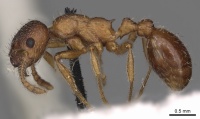Myrmica tibetana
| Myrmica tibetana | |
|---|---|

| |
| Scientific classification | |
| Kingdom: | Animalia |
| Phylum: | Arthropoda |
| Class: | Insecta |
| Order: | Hymenoptera |
| Family: | Formicidae |
| Subfamily: | Myrmicinae |
| Tribe: | Myrmicini |
| Genus: | Myrmica |
| Species group: | tibetana |
| Species complex: | tibetana |
| Species: | M. tibetana |
| Binomial name | |
| Myrmica tibetana Mayr, 1889 | |
Collected in subalpine meadows at altitudes over 3000 m.
Identification
Radchenko and Elmes (2010) - A member of the tibetana group. It has, like Myrmica tenuispina, frontal carinae that are strongly curved outwards in their anterior third, and wide, subsquare frontal lobes, but differs from the latter species by its short propodeal spines. We placed M. tibetana and M. tenuispina in the same group because the workers of both species have uniquely shaped frontal carinae and frontal lobes from among the Old World Myrmica species (Radchenko and Elmes 2001b). However the males of these two species have quite different length scapes, those of M. tibetana are distinctly longer than those of M. tenuispina (SI1 > 0.75 versus < 0.40, respectively).
Keys including this Species
Distribution
Tibet.
Latitudinal Distribution Pattern
Latitudinal Range: 37.144° to 33.655°.
| North Temperate |
North Subtropical |
Tropical | South Subtropical |
South Temperate |
- Source: AntMaps
Distribution based on Regional Taxon Lists
Oriental Region: Tibet (type locality).
Palaearctic Region: Afghanistan, China.
Distribution based on AntMaps
Distribution based on AntWeb specimens
Check data from AntWeb
Countries Occupied
| Number of countries occupied by this species based on AntWiki Regional Taxon Lists. In general, fewer countries occupied indicates a narrower range, while more countries indicates a more widespread species. |

|
Estimated Abundance
| Relative abundance based on number of AntMaps records per species (this species within the purple bar). Fewer records (to the left) indicates a less abundant/encountered species while more records (to the right) indicates more abundant/encountered species. |

|
Biology
Castes
Queens are unknown.
Nomenclature
The following information is derived from Barry Bolton's Online Catalogue of the Ants of the World.
- tibetana. Myrmica tibetana Mayr, 1889: 279 (w.) TIBET. Ruzsky, 1915a: 440 (m.). See also: Radchenko & Elmes, 2010: 304.
Unless otherwise noted the text for the remainder of this section is reported from the publication that includes the original description.
Description
Type Material
Seifert et al. (2019) - Mayr (1889) gave the following collecting data in his original description: “April 1884, Jumel-Kuku-Gebirge; Mai-Juni 1884 Tibet septentr.” The term “Jumel Kuku Gebirge” is undoubtedly a reading error of the original Cyrillic label. This original label was discarded by Mayr and should have read probably as “Южные Куку Гορы” = “Southern Kuku Mountains”. If handwritten as a script, “Южные” is easily misinterpreted by a person not familiar with Russian language. Reading the travelling report of Przewalski (1954), we found that the Southern Kuku (Nor) Mountains were reached in April 1884 and we assume as most probable collecting site a place near the pass road – approximately at 36.5° N, 99.7° E and 3700 m. We have investigated the lectotype worker labeled “Tibet” [handwriting of H. Stitz], “Myrmica tibetana Mayr” [handwriting of H. Stitz], “Forel ded. 1922”, “Zool. Mus. Berlin”, “Paratypus” [label probably attached by Stitz], “Lectotype Myrmica tibetana Mayr, 1889 [published by Radchenko & Elmes (2010), des. Seifert 2014]”; stored in Berlin Museum für Naturkunde der Humboldt-Universität. Note: Radchenko & Elmes (2010) published a specimen from ZMHB museum with the above labelling as lectotype but did not physically designate it and they also gave no morphological data to identify it unambiguously. However, as this type is the only specimen of Myrmica tibetana stored in the Berlin collection, we are rather sure to have labeled the right specimen. We further investigated a big series of 13 paralectotype workers, stored in Naturhistorisches Museum Wien, Vienna, labeled “Tibet Coll. G. Mayr”, “tibetana G.Mayr, Type”. One of these specimens shows a label “Lectotype Myrmica tibetana MAYR A.F. -1978” which is invalid as this physical lectotype designation by André Francoeur has not been published.
Etymology
Radchenko and Elmes (2010) - named for Tibet, the region where the type material was collected.
References
- Collingwood, C. A. 1961a [1960]. The third Danish Expedition to Central Asia. Zoological Results 27. Formicidae (Insecta) from Afghanistan. Vidensk. Medd. Dan. Naturhist. Foren. 123: 51-79.
- Mayr, G. 1889. Insecta in itinere Cl. Przewalski in Asia Centrali novissime lecta. XVII. Formiciden aus Tibet. Tr. Rus. Entomol. Obshch. 24: 278-280 (page 279, worker described)
- Radchenko, A. G. 1994a. Taxonomic structure of the ant genus Myrmica (Hymenoptera, Formicidae) of Eurasia. Report 1. Zool. Zh. 73(6 6: 39-51 (page 41, Senior synonym of furva)
- Radchenko, A.G. & Elmes, G.W. 2010. Myrmica ants of the Old World. Fauna Mundi 3: 1-789.
- Ruzsky, M. 1915a. On the ants of Tibet and the southern Gobi. On material collected on the expedition of Colonel P. K. Kozlov. Ezheg. Zool. Muz. 20: 418-444 (page 440, male described)
- Seifert, B., Schltz, R., Ritz, M.S., Ritz, C.M. 2018. Cryptic species of the Myrmica tibetana complex (Hymenoptera: Formicidae) revealed by integrative taxonomy. Myrmecological News, 27: 93-110.
References based on Global Ant Biodiversity Informatics
- Chen Z. L., S. Y. Zhou, and J. H. Huang. 2016. Seven species new to science and one newly recorded species of the ant genus Myrmica Latreille, 1804 from China, with proposal of a new synonym (Hymenoptera: Formicidae). ZooKeys 551: 85–128.
- Guénard B., and R. R. Dunn. 2012. A checklist of the ants of China. Zootaxa 3558: 1-77.
- Huang Jian-hua, Zhou Shan-yi. 2007. A checklist of family Formicidae of China - Myrmicinae (Part II) (Insecta: Hymenoptera). Journal of Guangxi Normal University : Natural Science Edition 25(1): 91-99.

